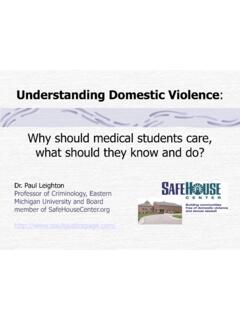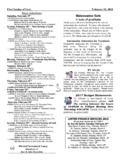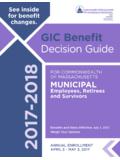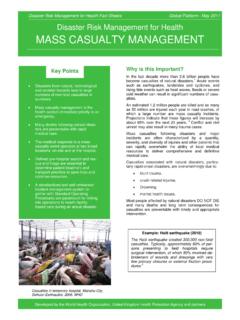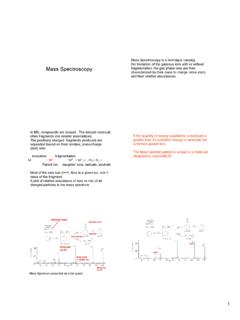Transcription of Mass Salmonella Poisoning by the Peanut Corporation Safety
1 mass Salmonella Poisoning by the Peanut Corporationof America: State-Corporate Crime Involving FoodSafetyPaul Leighton1 Springer Science+Business Media Dordrecht 2015 AbstractAnimal feces in food causes outbreaks of Salmonella Poisoning , whose assaulton the body results in several days of diarrhea, vomiting and even death. This paper looksat the massive distribution of Salmonella -contaminated peanuts in 2008 2009 that causednine deaths, 11,000 20,000 illnesses and the recall of 4000 products in the US. The PeanutCorporation of America operated filthy, sometimes unregistered, plants and shippedproducts to major food manufacturers and schools after receiving test results positive forsalmonella. This corporate crime was facilitated by substantial weaknesses in regulation,and is thus a state-facilitated corporate crime. This case study is developed by looking atthe Peanut plant conditions, decisions of executives, regulatory failure, and overallresponse.
2 The conclusion asks about the puzzle of the state responding to a crime itfacilitated, and how to understand the role a Corporation victimizing another corporationplays into the November of 2008, the Centers for Disease Control and Prevention (CDC) noticed amultistate outbreak of Salmonella that eventually led to nine deaths and 714 confirmedcases of illness (CDC2009a). At least 166 people were hospitalized, with an estimated11,000 (Cavallaro2011, 601 and 607) to 20,700 total cases (Sheth et ).1 Salmonellainfections in people last 4 7 days, causing diarrhea, fever, abdominal cramps, and vom-iting (Marler2011). While most people recover from this bacterial assault without&Paul of Sociology, Anthropology and Criminology, Eastern Michigan University, Ypsilanti,MI 48197, USA1 Cavallaro (2011) suggest that the total cases were 16 times higher than the reported cases, producing thelow estimate; Sheth et al.
3 (2011), use 29 as a multiplier. The CDC (2009b) notes that estimated 3 % ofSalmonellainfections are laboratory confirmed and reported to surveillance systems, suggesting a multi-plier of 30 33. The top estimate in the range is thus well within the probability curve rather than being anextreme CrimDOI , it can lead to hospitalization, permanent health impairments or death in theelderly, infants and those with weakened immune and public health officials traced the outbreak to the Peanut Corporation ofAmerica s (PCA) facility in Blakely, Georgia. PCA was a relatively small business thatsold industrial sized containers of Peanut butter and products to snack food makers,schools, the military, nursing homes and meals used for disaster relief. PCA claimed theproblem was isolated, but a former employee, Kenneth Kendrick, went onGood MorningAmericato refute that and draw attention to a PCA facility in Plainview, Texas.
4 The planthad a flooded basement, rats, and a hole in the roof that dripped rain contaminated withbird poop into the production area; it was unlicensed for food production and had neverundergone a sanitation inspection. The Texas Department of State Health Services (2009)shut down the plant and ordered the recall of everything the plant had ever produced. Therecalls from all PCA facilities ultimately included about 4000 products, which the FDAsaid was one of the largest food recalls ever in the United States (2009a).On February 11, 2009, PCA s CEO, Stuart Parnell, appeared in front of the HouseSubcommittee on Oversight and Investigations, which released information that PCA hadon multiple occasions knowing shipped Peanut products that tested positive for Greg Walden put various recalled Peanut products in a big glass jar wrapped withyellow CAUTION tape and asked Parnell if he would eat any. Parnell plead his FifthAmendment right not to incriminate himself.
5 Two days later, PCA declared victims split $12 million in insurance (Bottemiller2010) and top PCA employees splitan $875,000 insurance policy for their legal bills (Flynn2009). The Peanut recall was oneof several widespread food Safety issues that led to the Food Safety Modernization Act of2010, a significant overhaul of food Safety regulation. More than 4 years after the HouseSubcommittee laid out a number of incriminating emails, the Department of Justicereturned a 76 count criminal indictment against Parnell and other PCA PCA executives were found guilty, and although the appeals process is just startingat the time of publication, PCA is an important case study of corporate crime. Althoughthis $30 million a year business (and Parnell s $ million salary) is small in comparisonto the Fortune 500, PCA s leadership, acting in their occupational roles, caused a majorpublic health event. Further, this wrongdoing occurs within a context of regulatory example, surprisingly few industry best practices for sanitation and the proper responseto positive Salmonella test results were codified in Food and Drug Administration (FDA)regulations; inspections in Georgia missed much, while Texas did not catch the unregis-tered food production company operating in the state.
6 Thus, the appropriate analytic lens isstate-corporate crime (Michalowski and Kramer2006), which are illegal or sociallyinjurious actions that result from mutually reinforcing interactions between governmentsand corporations when they pursue goals that intersect (Aulette and Michalowski2006,47).State-corporate crime exists on a continuum from acts that are state-initiated to state-facilitated, with the latter including bureaucratic failure and regulatory dysfunction(Kauzlarich et , 247). Like the Imperial Foods fire (Aulette and Michalowski2006), the crash of ValuJet Flight 592 (Matthews and Kauzlarich2006), and the Bridge-stone-Firestone tire tread separations (especially on Ford Explorers) (Mullins2006), PCAis a case of state-facilitated crime. They all involve the pursuit of profit by corporationsalong with the failure of a state agency to effectively monitor them [that] resulted in theviolent deaths (Matthews and Kauzlarich2006, 83) of innocent citizens who wereworking, flying, driving or Leighton123 The failure by the state can result from the conscious pursuit of a business friendly environment that minimizes criminal liability for corporations and their executives, reg-ulates reluctantly and promotes weak, underfunded, even dysfunctional, regulatory agen-cies.
7 The problem of state-facilitated crime is most problematic in areas where business-friendly anti-regulatory values trump government s assigned or implied trust/duty to thepublic (Kauzlarich et , 247) and food Safety is clearly one of those areas. Aperson whose father died from Salmonella (Tousignant2009, 2) asked the House com-mittee, how can we truly be leaders of the free world if we can t keep our citizens safefrom food we eat every day[?] His father fought for his country. He died because he atepeanut butter. 2 PCA is thus an important case study of state-facilitated corporate crime that extends thevalidity and utility of the concept in the area of food Safety , where regulation deficiency (Griffin and Miller2011, 223) is especially noteworthy. There is no long form account tosystematically examine this corporate mass victimization, although existing sources can bestitched together to provide a thorough account of the problems and responses.
8 Further,other case studies focus on multinational corporations that abused their substantial power,but PCA is a relatively small wholesale company and sold mostly to other food manu-facturers. So, the immediate victims of this corporate crime included substantially largermultinational corporations, whose products then went on to kill and injure the public. Assuch, this case opens up questions about the corporate victimization of other corporations,and how that victimization affects the paper starts by providing a brief overview of Salmonella as it relates to peanutprocessing. The food Safety lesson provides a basis for understanding PCA s failures andwrong doing. A second section reviews bureaucratic and regulatory failure at the federallevel as well as in Texas and Georgia, the states where PCA had offending operations. Italso reviews the Congressional, regulatory and criminal responses as well as piece is built from research with additional information from the whistleblowerKenneth Kendrick.
9 Mr. Kendrick worked as an assistant manager for production 3 monthsin 2006 in the Plainview, Texas PCA plant. He provided helpful background information,details about the plant that are not in print, and clarified questions about previouslyreported accounts. Quotes attributed to him that lack a citation are from our emailexchanges and telephone discussions from 2012 to , Peanuts, and the Peanut Corporation of AmericaSalmonella bacteria occur naturally in animal and human feces, but geographically diversecases that have matching genetic fingerprints occur because animal feces contaminatedlarge scale food production. While Salmonella poses a challenge in the processing of manyfoods, the following provides a brief, focused review of Salmonella and Peanut is important to understand the flaws in procedures and operations at PCA, which aredetailed in the subsequent s customers included pet food manufacturers which was also recalled leading another witness(Hurley2009, 4) to note: Even my dog is not safe!
10 What is this, China?! . mass Salmonella Poisoning by the Peanut Corporation and Peanut ProcessingPeanuts growing in the ground can become contaminated with Salmonella through irri-gation water containing feces or the use of animal feces that were not fully conditioned intomanure for fertilizer (Cavallaro2011; Sheth et ). Exposure also can occur throughcontact with contaminated soil on harvesting and transport equipment, as well as rodentdroppings during short- or long-term processes should involve a kill step, usually heating the food for acombination of time and to a temperature to kill Salmonella (and other pathogens) beforehuman consumption. Under ideal conditions, Peanut roasting should kill Salmonella (Cavallaro2011; Sheth et ). But wide variations in the type of peanuts and theirmoisture content (older, dryer peanuts need less roasting time) mean that Salmonella maysurvive roasting. Best practices dictate the segregation of raw (potentially contaminated)food from product that has been through a kill step to remove the possibility for cross-contamination.
